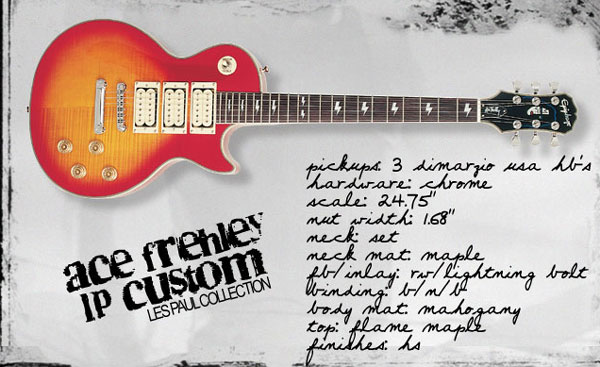
When Gibson signs an agreement/contract to build signature model guitars, with one of their major artists, like Ace Frehley, Slash or Zakk Wylde; the contract will usually have multiple components to it. In the world of Gibson guitars this means a Custom Shop model (The 300), a Gibson USA model (The Production Models) and an Epiphone model. The actual numbers of guitars to be produced by each facility will be different, depending on the artist. So, with the exception of The 300, built at Gibson's Custom Shop, I can't tell you how many guitars, Epiphone was required to build. If I was to give a ballpark number, I would estimate somewhere between 1,000 and 1,500, in total.
The Ace Frehley Signature Epiphone Les Paul guitars were all built by the Saein Musical Instrument Company at their manufacturing facility in Incheon, Korea between the years of 1997 and 2008. The proof of this is in the serial numbers and specifically, the letter 'I' as the prefix.
There is always some confusion about a small sticker that is applied to some of the Epiphone guitars, including some of the Ace Frehley models, that reads "100% Inspected & Set-Up In The USA by ____" (with the blank space having a number in it). What does this actually mean, you ask ? Well, here's the answer ... The Saein factory will ship all Epiphone guitars destined for US distribution to Epiphone's distribution facility in Nashville. It's actuall located right beside the Gibson USA facility. Here in Canada, the guitars are shipped to Yorkville Sound, outside Toronto, where they are distributed across Canada. The same is true for any/all Gibson and Epiphone distributors, around the world. Once at these distribution facilities, they are inspected for any damage or oddities (for example ... a model that was intended for Japanese release only that was accidentally shipped to the wrong country). When the guitar passes inspection, in the USA at least, they apply the small sticker to the back of the head of the guitar.
The thing that I always found unusual about the Epiphone Ace Frehley models was their lack of Grover machine heads. Regular production Epiphone guitars have Grovers on them, but the Ace models didn't. They were produced with a reproduction of a mid-1970's, metal, "tulip" button tuner. The guitars were loaded with 3, authentic, DiMarzio Super Distortion pickups, no pickguard and creme colored back plates on all versions.
Most of the guitars I have come across have Ace's signature at the 12th fret, in a fashion similar to the higher-end Gibson models. However, I have also come across a few that have two lightning bolts at the 12th fret. At this time, I don't have an answer as to why these exist, but they do exist.
The last point that was unique to the Epiphone models was the color options. I touched on this on the "Current Values" page where I indicated that there were 3, different color options available. 2 of these were readily available in the North American and Western European markets and they were the Cherry Sunburst version and a Black Burst version. The 3rd, was an exclusive, for the Japanese market and it was the limited edition, Silver Flake Blue Burst model. Many of these guitars have slowly made their way around the globe, but initially, they were not so wide-spread.
Epiphone Ace Frehley Model headstock

Epiphone inspection sticker for USA

Epiphone ad for the Ace Frehley Les Paul Custom
This ad features the version with the double lightning bolts at the 12th fret

Epiphone ad featuring Ace, in time for the Psycho Circus tour

Epiphone ad for the Silver Flake / Blue Burst Ace Frehley Les Paul Custom
This ad features the version with the double lightning bolts at the 12th fret and a black truss rod cover ... but they didn't all have these features

This example features the more typical "Ace Frehley" signature at the 12th fret and a white truss rod cover


This is a great shot of an Epiphone Ace Frehley Signature Black Burst
Epiphone Ace Frehley Signature Black Burst Les Paul Custom
clearly showing the creme colored back plates